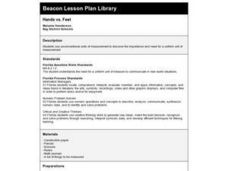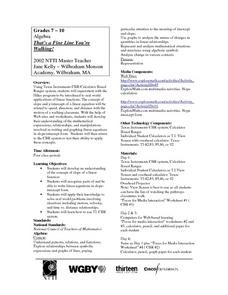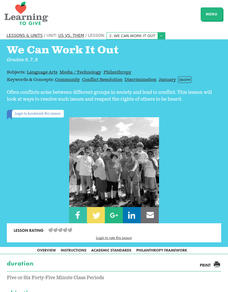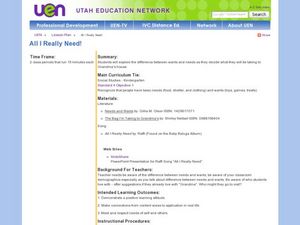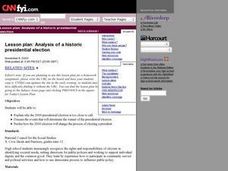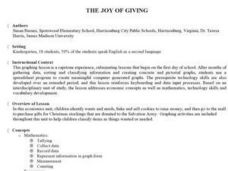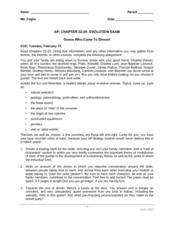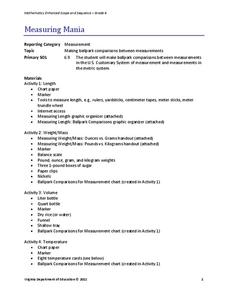Curated OER
Lift vs. Airspeed
Students, after reading the explanation given below, use FoilSim and a graphing calculator to complete the activity to determine the relationship between airspeed and lift of an object by interpreting data.
Curated OER
Hands Vs. Feet
First graders use unconventional units of measurement to discover the importance and need for a uniform unit of measurement.
Curated OER
Need vs. Wants in Creating Sustainable Communities
Ninth graders create a T chart of their needs and wants. In this environmental science lesson, 9th graders brainstorm ideas on how to create a sustainable community. They decide what they would give up and keep to make the community...
Curated OER
My Living Arrangements
Students identify various housing options, focusing on rental vs. purchase and short vs. long term. With a partner, students discuss their housing situation. Once their discussion is complete, students write a brief paragraph weighing...
Curated OER
Field Trip!: A Visit to the Grocery Store
Students discover that foods are organized into groups of similar items by developing vocabulary to enhance verbal discussion i.e., real experiences provide the foundation for thoughtful discussion and critical thinking. They then...
Curated OER
Scale and Image Reproduction
Students practice using mathematical issues of scale. They compare and contrast digital images verses the object in real life. They share their observations with the class.
Curated OER
That's a Fine Line You're Walking!
Pupils experiment with Hiker program to practice real world applications of linear functions and develop their understanding of expressions, relationships, and manipulations involved in writing and graphing linear equations in...
Curated OER
Harry Potter: Middle Grades Activity
Students identify inferred and recurring literary, cultural and social themes such as bravery, loyalty, friendship and the notion of good vs. evil.
Curated OER
Tornadoes
Students use the Internet to research tornadoes. They consider tornado formation, energy forms and sources, ways to predict tornadoes, tornado safety and attempt to predict tornadoes in real time.
Curated OER
We Can Work It Out
Students read different pieces of literature and practice using narrative reading strategies to gain meaning. They use conflict resolution techniques found in literature and apply it to a real world situation. They discover how important...
Curated OER
How the Electoral College Works
Learners research the history and mechanics of the Electoral College and formulate opinions as to whether this institution should be preserved, modified or eliminated. They predict future outcomes of electoral vs. popular votes.
Curated OER
Airplanes
Fourth graders experiment with gravity and lift by building paper airplanes. In this physics lesson, 4th graders compare the falling rate of a crumpled vs. flat sheet of paper. Then after class discussion and demonstration of Bernoulli's...
Curated OER
BLAST Algorithm
Students explore a series of activities on using BLAST. In this biology lesson plan, students explain the significance of BLAST in DNA query. They give real world applications of BLAST.
Curated OER
Money Management Intelligence
Students follow directions to help a client with his/her budget. After selecting their client, they download confidential data and listen to the challenge presented on the website. They adjust the budgets as needed. Then, they click play...
Curated OER
All I Really Need!
Students differentiate between wants and needs. In this basic needs lesson, students prepare to pack for a trip to grandma's house and determine what they need for the trip and what they want for the trip.
BW Walch
Creating and Graphing Linear Equations in Two Variables
This detailed presentation starts with a review of using key components to graph a line. It then quickly moves into new territory of taking these important parts and teasing them out of a word problem. Special care is...
Baylor College
HIV/AIDS in the United States
In the final of five lessons about HIV/AIDS, groups create presentations to share data about the infection rates in the United States, examining demographic and geographic trends over the past ten years. Depending on how much time you...
Curated OER
Analysis of a Historic Presidential Election
Students research the 2000 presidential elections. They explain why the presidential winner was initially too close to call, discuss how the winner was determined and predict how the 2000 election might change the process of electing a...
Curated OER
Spending: Spend Wisely
Young scholars investigate the basics of pricing and the long-term effects of smart spending. They explore the "Bargain Basement" section of the ING website, read about a boy's ideal meal, complete a worksheet that compares the cost of...
Curated OER
The Joy of Giving
Children identify wants and needs, bake and sell cookies to raise money, and then go to the mall to purchase gifts for Christmas stockings that are donated to the Salvation Army. They then perform Graphing activities to help children...
Curated OER
Investigation of Hooke's Law Lab
Students determine the spring constant by conducting an investigation. In this physics lesson, students collect data and create a graph of force vs. displacement. They compare the results of two different methods to find spring constant.
Curated OER
Guess Who Came to Dinner!
An exceptionally creative approach is taken to assessing your biologists' grasp of natural selection concepts. They are to imagine hosting Charles Darwin for dinner and having, to their surpise, a few other noted scientists crash the...
Curated OER
Producing Beats
Turn your classroom into a music studio as groups work together to determine why music sounds different when performed live versus a recording. After listening to some different music, each group picks a poem, creates a recording, and...
Virginia Department of Education
Measuring Mania
Conversion immersion — it's measuring mania! A set of four activities teaches scholars to convert between customary and metric units. Resource covers unit conversions in length, temperature, weight/mass, and volume.

